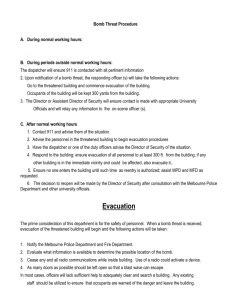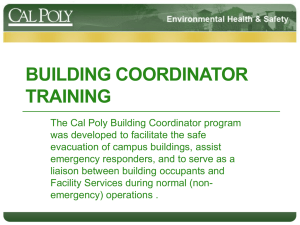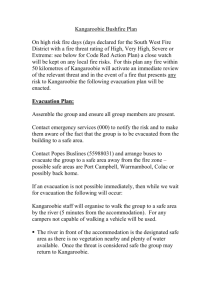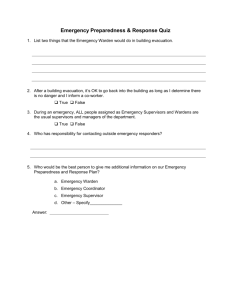Emergency preparedness and response procedure
advertisement
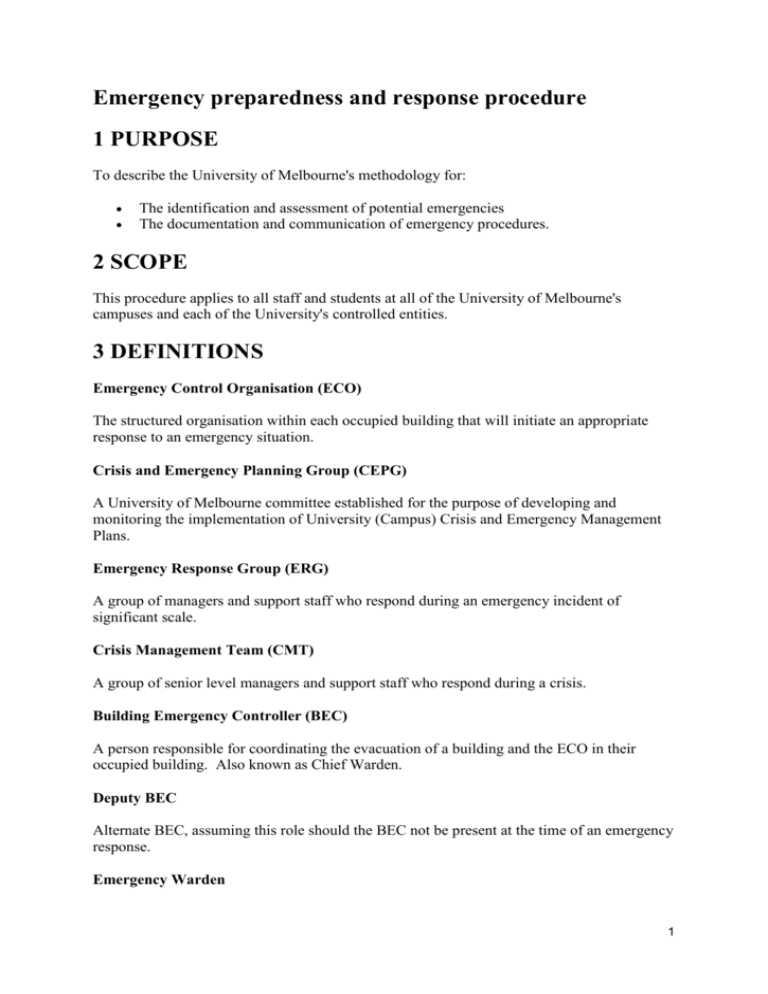
Emergency preparedness and response procedure 1 PURPOSE To describe the University of Melbourne's methodology for: The identification and assessment of potential emergencies The documentation and communication of emergency procedures. 2 SCOPE This procedure applies to all staff and students at all of the University of Melbourne's campuses and each of the University's controlled entities. 3 DEFINITIONS Emergency Control Organisation (ECO) The structured organisation within each occupied building that will initiate an appropriate response to an emergency situation. Crisis and Emergency Planning Group (CEPG) A University of Melbourne committee established for the purpose of developing and monitoring the implementation of University (Campus) Crisis and Emergency Management Plans. Emergency Response Group (ERG) A group of managers and support staff who respond during an emergency incident of significant scale. Crisis Management Team (CMT) A group of senior level managers and support staff who respond during a crisis. Building Emergency Controller (BEC) A person responsible for coordinating the evacuation of a building and the ECO in their occupied building. Also known as Chief Warden. Deputy BEC Alternate BEC, assuming this role should the BEC not be present at the time of an emergency response. Emergency Warden 1 A person responsible for an area or floor of their occupied building, in which they evacuate all people present. University Occupied Building A building that he University of Melbourne owns or leases from another party, in which the University is the primary (major) occupant. University Minor Occupant A building in which the University of Melbourne is a secondary (minor) occupant of the total building, for example University-occupied areas within hospitals. 4 PROCEDURES 4.1 University-Wide Emergency Management The University must establish and maintain an Emergency Control Organisation based upon the requirements of AS 3745. 4.2 Crisis and Emergency Planning Group The University must establish a Crisis and Emergency Planning Group (CEPG) in accordance with the CEPG Terms of Reference [.pdf]. 4.3 Assessment of Potential Emergencies The Director, OHS and Injury Management the Director, Campus Operations must ensure that a high level assessment of potential emergencies at the University is conducted and reviewed annually. This assessment must include consideration of the following: Fire Rubbish fire, bush fire, electrical fire, oil / fat fire, gas fire. Medical Emergency Heart attack, burns, cuts/lacerations, asthma, poisons. Internal Emergency Flood, chemical spill, power failure, structural instability. Health & Safety Serious Incident & Dangerous Occurrence. External Emergency Gas leak, civil disturbance, vehicle accident, severe storm damage. 2 Bomb or Substance Threat Chemical, biological or radiological threat, suspicious package. Armed or Aggressive Intruder Building invasion, armed intrusion, assault, act of terrorism. 4.4 Emergency Management Plans & Response Procedures The Emergency Management Coordinator must develop emergency preparedness and response procedures for each potential emergency assessed to be significant. The Emergency Management Coordinator must review emergency preparedness and response procedures for each potential emergency assessed to be significant: following a change in the assessment level; following a emergency management response exercise; or at least annually. The Emergency Management Coordinator must provide a draft version of new or altered Emergency Management Plans to the CEPG for formal review. The Emergency Management Coordinator must take into account feedback provided by the members of the CEPG. Following the formal review and feedback process, the Emergency Management Coordinator must re-submit reviewed Emergency Management Plan to the CEPG for authorisation by the Chair of the CEPG. The Emergency Management Coordinator must advise the CEPG on: establishing and implementing emergency plans and emergency response procedures; review of the effectiveness of Evacuation Training Exercises; the personnel required to implement emergency response procedures. The Emergency Management Coordinator must establish and implement Building Emergency Procedures for each of the University of Melbourne's occupied buildings. The Emergency Management Coordinator must take into consideration all likely occupants of building, including: tenants (where the University is the landlord); contractors to the University; visitors to the University. Staff, students and other occupants must familiarise themselves with Emergency Evacuation Plans, including allocated emergency response personnel in each building that they occupy. 3 Staff, students and other occupants must comply with the University of Melbourne's Building Emergency Procedures including instructions or directions given by BEC's or Emergency Wardens. 4.5 Building Emergency Control Organisation – University Buildings The Director, OHS and Injury Management must facilitate the establishment and maintenance of the Building Emergency Control Organisation in each University-occupied building. The ECO must consist of: Building Emergency Controllers Emergency Wardens Building Emergency Procedures Communication Procedures Emergency Evacuation Plans Evacuation Exercises The Head of Department/School with primary (major) occupancy of a University-occupied building, must ensure that a Building Emergency Controller and Deputy Building Emergency Controller is appointed for that building. The Head of Department/School with secondary (minor) occupancy of a University-occupied building must ensure that Emergency Wardens are appointed for their occupied areas within that building. The Head of Department/School must ensure that information identifying local emergency response personnel is displayed in each area that the department/school occupies Emergency Contacts template [.doc] 4.6 Building Emergency Control Organisation – Non University Buildings Where the University is a minor occupant in a building, the Head of Department/School must ensure that occupants under the University’s management and control cooperate and participate in the established ECO for that building. Where a building does not have an ECO established or the ECO is deemed inadequate for the University occupants, the Director, OHS and Injury Management must facilitate the establishment and maintenance of an ECO within the area of the building that the University occupies. The Emergency Management Coordinator must, in consultation with the BEC, develop and maintain: Building Emergency Procedures; Communication Procedures; Emergency Evacuation Plans. 4.7 BEC and Warden Competencies 4 The Emergency Management Coordinator must develop and maintain training packages that meet the relevant competencies prescribed by AS 3745 for: BEC and Deputy BEC Wardens. BEC, Deputy BECs and Wardens must be required to successfully complete the relevant training. Staff and permanent occupants of University buildings must receive training in building emergency response through local workplace induction and Evacuation Exercise Drills. Managers and supervisors must ensure that contact details of local emergency response personnel are displayed in the building, such that they are visible to all occupants. 4.8 Testing Building Emergency Plans and Procedures The BEC for each building must ensure that the building occupants participate in a minimum of one Evacuation Training Exercise (Drill) per year. The Director, OHS and Injury Management must ensure that building evacuation training exercises are monitored and recorded centrally. ECO personnel must participate in Emergency Training Exercises in order to evaluate emergency procedures. The BEC, on becoming aware of an emergency (or activation of a training exercise), must: Ascertain the nature of the emergency and determine the appropriate action; Ensure emergency wardens have been notified of the emergency, usually via the building's emergency alarm system; Coordinate evacuation and control entry to the affected areas; Ensure the progress of the evacuation and any action taken is recorded in an incident log; Brief the emergency services personnel upon arrival on type, scope and location of the emergency and the status of the evacuation and, thereafter, act on the incident controller's instructions; Complete an evacuation report, documenting details for the purpose of identifying and correcting any deficiencies in procedure or its implementation. The BEC must conduct a review after each emergency evacuation or exercise to identify improvement to the building evacuation procedures. The BEC must record the findings of the review on an Evacuation Report and provide a copy of the Evacuation Report to the Emergency Management Coordinator. The Emergency Management Coordinator must evaluate all findings of the Evacuation Report and correct any deficiencies in procedure or its implementation. 4.9 Testing University (Campus) Emergency Plans and Procedures 5 The Executive Director (Property & Campus Services) must arrange the periodic testing of the University (Campus) Emergency Plans and associated procedures to ensure their effectiveness. The Executive Director (Property & Campus Services) must ensure that a debriefing session is conducted after each exercise (or activation of the ERG) to identify areas for improvements to the plan or procedures. The Emergency Management Coordinator must review the Emergency Management Plan following the debriefing. 5 RESPONSIBILITIES Executive Director, Property & Campus Services Director, OHS and Injury Management Director, Campus Operations Director, Asset Services Head of Department/School Emergency Management Coordinator Manager Supervisor Building Emergency Controllers Emergency Warden Staff Students Tenants Visitors and other occupants 6 REFERENCES AS 3745: Planning for emergencies in facilities The University of Melbourne Emergency Management Plan The University of Melbourne Building Emergency Procedures 6 The University of Melbourne Emergency Action Guide 7 DOCUMENT CONTROL Established by: RMC on 6 March 2007 Date: 26 June 2012. Version 2.1 Next Review: 26 June 2015 Authorised: Director, OHS and Injury Management (c) The University of Melbourne - uncontrolled when printed. 7


